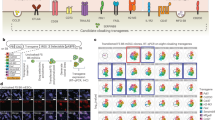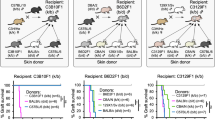Abstract
No convincing evidence exists which demonstrates that mammalian thymus cells can directly express their immunological activity. It has been assumed, therefore, that the immunological role of the thymus is an indirect one, that is, that it supplies the ‘executive’ part of the immune machinery of the body with cells the replication of which may well be required to establish normal immune function. Nevertheless, the relationship of thymus cells to the plasma cells as well as to the population of small lymphocytes (which has been considered to be linked with several immune manifestations including tolerance1,2) is still obscure. A similar concept could be applied to the immunological function of the thymus in birds. However, some observations made in chickens have suggested that cells derived from the thymus might be properly qualified to induce directly an immune response or at least to participate in it3–7. This report provides some evidence to show that the thymus is capable of inducing a state of tolerance to skin homograft in the chicken.
This is a preview of subscription content, access via your institution
Access options
Subscribe to this journal
Receive 51 print issues and online access
$199.00 per year
only $3.90 per issue
Buy this article
- Purchase on Springer Link
- Instant access to full article PDF
Prices may be subject to local taxes which are calculated during checkout
Similar content being viewed by others
References
Gowans, J. L., McGregor, D. D., Cowen, D. M., and Ford, E. E., Nature, 196, 651 (1962).
Gowans, J. L., McGregor, D. D., and Cowen, D. M., in The Immunologically Competent Cell, edit. by Wolstenholme, G. E. W., and Knight, J., 20 (Little Brown, Boston, 1963).
Willier, B. H., Amer. J. Anat., 33, 67 (1924).
Ebert, J. D., Proc. U.S. Nat. Acad. Sci., 40, 337 (1954).
Solomon, J. B., J. Embryol. Exp. Morphol., 9, 355 (1954).
Owen, J. J. T., Mawdsley, A. R., and Harrison, G. A., Transplantation, 2, 503 (1964).
Jankovié, B. D., Išvaneski, M., and Mitrović, K., Intern. Arch. Allergy, 26, 18 (1965).
Ballantyne, D. L., Transpl. Bull., 6, 110 (1959).
Biggs, P. M., and Payne, L. N., Nature, 184, 1594 (1959).
Burnet, F. M., and Boyer, G. S., J. Path. Bact., 81, 141 (1961).
Warner, N. L., Austral. J. Exp. Biol. and Med. Sci., 42, 401 (1964).
Hašek, M., Folia Biol., 8, 73 (1962).
Mitchison, N. A., in Biological Problems of Grafting, edit. by Albert, E., and Lejeune-Ledant, G., 239 (Blackwell, Oxford, 1959).
Szenberg, A., and Warner, N. L., Nature, 194, 146 (1962).
Jankovié, B. D., and Išvaneski, M., Intern. Arch. Allergy, 23, 188 (1963).
Jankovié, B. D., and Isakovié, K., Intern. Arch. Allergy, 24, 278 (1964).
Cooper, M. D., Peterson, R. D. A., and Good, R. A., Nature, 205, 143 (1965).
Author information
Authors and Affiliations
Rights and permissions
About this article
Cite this article
JANKOVIĆ, B., ISAKOVIĆ, K. Suppression of Homograft Immunity in Chickens grafted in ovo with Allogeneic Thymus. Nature 211, 93–94 (1966). https://doi.org/10.1038/211093b0
Issue Date:
DOI: https://doi.org/10.1038/211093b0
This article is cited by
-
Thymus and adoptive transfer of antibody formation
Experientia (1968)
Comments
By submitting a comment you agree to abide by our Terms and Community Guidelines. If you find something abusive or that does not comply with our terms or guidelines please flag it as inappropriate.



